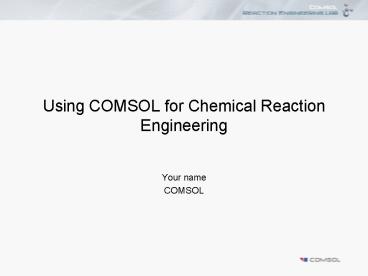Using COMSOL for Chemical Reaction Engineering - PowerPoint PPT Presentation
1 / 37
Title:
Using COMSOL for Chemical Reaction Engineering
Description:
... Engineering. Understanding the influence of chemical ... Optimizing the chemical process in ideal reactors. Exploring design in detailed reactor geometries ... – PowerPoint PPT presentation
Number of Views:873
Avg rating:5.0/5.0
Title: Using COMSOL for Chemical Reaction Engineering
1
Using COMSOL for Chemical Reaction Engineering
- Your name
- COMSOL
2
Overview
- COMSOL in two minutes
- The COMSOL product line
- Modeling in reaction engineering
- Reaction Engineering Lab
- COMSOL Multiphysics
- Example studies
- Heterogeneous catalysis
- Homogeneous catalysis
- Concluding remarks
3
The company
- Released COMSOL Multiphysics in 98
- 150 employees
- 15 offices
- Network of distributors
- Growth of 30 last year
98
99
00
01
02
03
04
05
06
4
The COMSOL product line
5
Reaction Engineering
- Understanding the influence of chemical reactions
in a process - and using that knowledge to achieve goals
in development and design - Covers a broad range of applications on widely
different scales
6
Modeling in Reaction Engineering
- Modeling is a natural part of developing and
optimizing chemical processes - Enters at all levels
- Modeling the chemical reactions
- Calibrating the reaction model with experimental
data - Optimizing the chemical process in ideal reactors
- Exploring design in detailed reactor geometries
7
Reactor Models
- Space and time-dependent tank reactor
8
Reactor Models
- Ideal tank reactors are perfectly mixed
9
Reactor Models
- Ideal tank reactors are perfectly mixed
10
Reactor Models
- Space and time-dependent flow reactor
11
Reactor Models
- Ideal tubular reactors are at steady-state
12
Reactor Models
- Ideal tubular reactors are at steady-state
13
Ideal or space-dependent models?
- Ideal reactors
- Well established concept
- Often adequate
- Computationally cheap
- Space-dependent reactors
- Detailed reactor information, e.g.
- Temperature distribution
- The effect of recirculation zones
- Detailed mass transport in concentrated mixtures
etc - Computationally demanding
14
Reaction Engineering Lab
- Screen and evaluate reaction sets
- Calibrate the chemistry with experimental data
- Optimizing the chemical process in ideal reactors
- Transfer the kinetic model and physical
properties of the reacting mixture from ideal
reactors to space-dependent systems
15
Chemical Reactions
- Screen reaction sets
16
Chemical Reactions
- Calibrate the chemical model with experimental
data
rate constants
k1 4.8 103 s-1 k2 4.9 106 s-1 k3 5.1 106
s-1
17
Ideal Reactor Models
- Ideal tank reactors
- Batch reactor
- Semibatch reactor
- CSTR
- Ideal tubular reactors
- Plug-flow reactor
18
Ideal Reactor Models
- Perform reactor analysis and design
19
Space-dependent Models
- Transfer the kinetic model and physical
properties of the reacting mixture from ideal
reactors to space-dependent systems - Move into detailed reactor analysis and design
20
COMSOL Multiphysics
- Set up and solve time and space-dependent models
- Build your model by combining application modes
- Fluid flow
- Mass transport
- Energy transport
- Structural mechanics
- Electromagnetics
- Explore and optimize chemical processes in
detailed reactor geometries
21
Chemical Engineering Module
- Fluid flow application modes
- Laminar flow
- Turbulent flow
- Flow in porous media
- Non-Newtonian flow
- Compressible flow
- Two-phase flow
22
Chemical Engineering Module
- Mass transport application modes
- Diffusion
- Convection and Diffusion
- Multi-component transport
- Ionic migration
- Energy transport application modes
- Conduction
- Convection and conduction
- Radiation
23
NOx reduction in a catalytic converter
- Selective reduction of NO by NH3
- Honeycomb monolith with V2O5/TiO2 catalyst
- Plug-flow model
- Space-dependent model
Image courtesy of ArvinMeritor
24
NOx reduction in a catalytic converter
- Competing reactions
- NO reduction by NH3
- NH3 oxidation
- Eley-Rideal kinetics
- Plug-flow model of a channel
25
Reaction Engineering Lab
26
Space-dependent model
- A cylindrical monolith channel
- Free flow in the center coupled to porous media
flow in the catalytic wash-coat - Reactions occur in the porous wash-coat
catalytic wash-coat
0.36 m
channel inlet
27
COMSOL Multiphysics
28
Homogeneous catalysis in a bubble column
- Ibuprofen synthesis
- Bubble column reactor with organometallic Pd
catalyst in the liquid phase - Ideal batch reactor model
- Space-dependent two-phase model
29
Ibuprofen synthesis
- Homogeneous catalysis
- PdCl2(PPh3)
- Carbonylation reaction
- CO gas dissolves in the reacting phase
30
Reaction Engineering Lab
31
Space-dependent model
- Bubble column
- Two-phase flow
- Gas bubbles drive the flow
- 1 mm bubbles
- Volume fraction of gas 0,005, 0,001, 0,05
- Reactions occur in the liquid phase
32
COMSOL Multiphysics
33
Liquid flow as function of volume fraction of gas
- Vf 0.005
- Vf 0.001
- Vf 0.05
34
Dissolution of CO gas in liquid
- Vf 0.005
35
Dissolution of CO gas in liquid
- Vf 0.01
36
Dissolution of CO gas in liquid
- Vf 0.05
37
Concluding remarks
- Reaction Engineering Lab
- Explore chemical models
- Calibrate with respect to experiments
- Ideal reactor modeling
- COMSOL Multiphysics
- Space and time-dependent reactors
- Flow, mass and energy transport
- Arbitrary physics couplings































